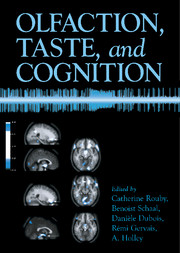Book contents
- Frontmatter
- Contents
- Contributors
- Preface
- Acknowledgments
- A Tribute to Edmond Roudnitska
- OLFACTION, TASTE, AND COGNITION
- Section 1 A Specific Type of Cognition
- Section 2 Knowledge and Languages
- Section 3 Emotion
- Section 4 Memory
- Section 5 Neural Bases
- 18 Odor Coding at the Periphery of the Olfactory System
- 19 Human Brain Activity during the First Second after Odor Presentation
- 20 Processing of Olfactory Affective Information: Contribution of Functional Imaging Studies
- 21 Experience-induced Changes Reveal Functional Dissociation within Olfactory Pathways
- 22 Increased Taste Sensitivity by Familiarization to Novel Stimuli: Psychophysics, fMRI, and Electrophysiological Techniques Suggest Modulations at Peripheral and Central Levels
- 23 The Cortical Representation of Taste and Smell
- Section 6 Individual Variations
- Index
- References
21 - Experience-induced Changes Reveal Functional Dissociation within Olfactory Pathways
Published online by Cambridge University Press: 21 September 2009
- Frontmatter
- Contents
- Contributors
- Preface
- Acknowledgments
- A Tribute to Edmond Roudnitska
- OLFACTION, TASTE, AND COGNITION
- Section 1 A Specific Type of Cognition
- Section 2 Knowledge and Languages
- Section 3 Emotion
- Section 4 Memory
- Section 5 Neural Bases
- 18 Odor Coding at the Periphery of the Olfactory System
- 19 Human Brain Activity during the First Second after Odor Presentation
- 20 Processing of Olfactory Affective Information: Contribution of Functional Imaging Studies
- 21 Experience-induced Changes Reveal Functional Dissociation within Olfactory Pathways
- 22 Increased Taste Sensitivity by Familiarization to Novel Stimuli: Psychophysics, fMRI, and Electrophysiological Techniques Suggest Modulations at Peripheral and Central Levels
- 23 The Cortical Representation of Taste and Smell
- Section 6 Individual Variations
- Index
- References
Summary
Learning more about the neural basis of olfactory cognition should greatly improve our understanding of how different brain structures deal with information. Progress can be facilitated by simultaneous advances with animal models and human studies, for in the olfactory system, conservatism across mammalian species in the organization of olfactory pathways allows integration of data obtained in animals and humans. In each species, output neurons from the olfactory bulb (OB) monosynaptically reach the piriform cortex (PC), the peri-amygdaloid cortex, and the lateral entorhinal cortex (LEC). The LEC provides massive input to the hippocampus, and the PC sends information to the orbitofrontal neocortical area, both directly and after a relay in the dorsomedial thalamic nuclei (Haberly, 1998). As in other sensory systems, two strategies have been developed thus far in order to identify hierarchical organization: collecting information from one structure at a time, and looking at the system as a network of interconnected structures. The first strategy is typical for most animal studies and is implemented through single-cell recordings in anesthetized animals (Mori, Nagao, and Yoshiara, 1999) and active animals (Schoenbaum, Chiba, and Gallagher, 1999; Weibe and Staubli, 1999; Wood, Dudchenko, and Eichenbaum, 1999) or through surface EEG recordings in awake restrained animals (Freeman and Skarda, 1985). When using anesthetized animals, most studies have focused on the OB, and fewer on the PC. When using active rats, such studies have investigated hippocampal, amygdalar, and orbitofrontal electrophysiological characteristics.
Information
- Type
- Chapter
- Information
- Olfaction, Taste, and Cognition , pp. 335 - 349Publisher: Cambridge University PressPrint publication year: 2002
References
Accessibility standard: Unknown
- 1
- Cited by
